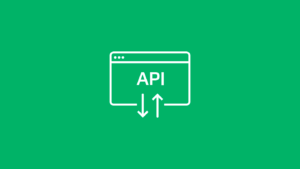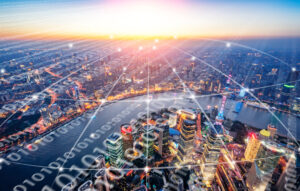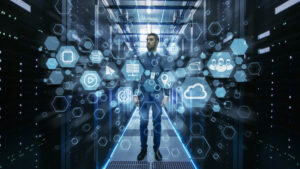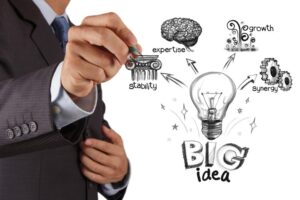14 Industries the Internet of Things is Disrupting
The Internet of Things is the next big disruptor in tech. Scalable Workload Automation will help IT coordinate and integrate with disparate tools.
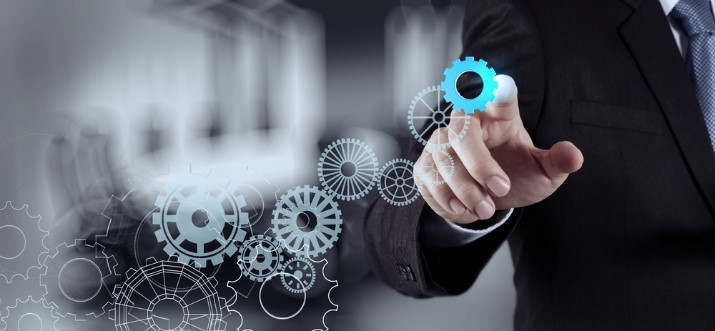
The Internet of Things is disrupting the industries we work in, whether or not we’re prepared. Here, we’ve compiled a list detailing how 14 major industries are already leveraging IoT.
What is the Internet of Things Being Used For?
he Internet of Things (IoT) is the next big disruptor in tech, with over 16.7 billion active endpoints expected in 2023, according to TechTarget.com. The U.S. industrial IoT market is expected to hit $66.28 billion in 2023 and grow at a rate of 11.5% over the next five years, according to Statista.com. This means that IT (because you can’t have IoT technology without IT) is going to have a lot more work on its plate.
The power of IoT is that each “Thing” has sensors which can collect and send data and communicate with other “Things”. This allows companies to turn their warehouses (or shops, offices, factories, seaports, etc.) into sensitive, highly coordinated environments that are always collecting data —and always improving. Many IoT projects fall under a larger umbrella of digital transformation initiatives.
An IoT device has two primary capabilities: it can collect and send data and it can complete an action (like a robotic arm on a factory floor). IoT technology becomes exceptionally powerful when it is brought to scale, when an organization uses thousands of sensors to collect data or coordinates the actions of hundreds of factory robots, for example. Algorithms then analyze the data, providing additional insights into usage trends and help predict issues before they can disrupt operations.
In order to maintain efficiency at such scale, IT needs to leverage automation solutions to help pass information and manage dependencies between different smart devices. Those devices might even be operating on different systems using wi-fi and bluetooth, as is the case when a hospital passes data from patient monitors to a server and then to doctors and nurses.
To do this, IT needs scalable automation solutions that can coordinate and integrate with disparate smart devices, platforms, software, and infrastructure. Workload Automation, for example, allows IT to coordinate, automate, and manage the processes that run IoT, giving IT the scalability it needs, and allowing IT to monitor and manage their IoT environments from a single interface.
It doesn’t matter what market or industry your organization is in: IoT is already empowering your competitors. Check out the list below to see how IoT is impacting 14 major markets.
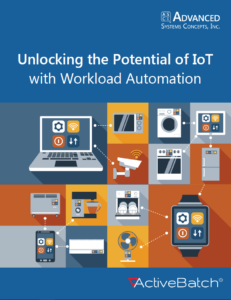
Get the Free white paper:
The Internet of Things is Disrupting These 14 Industries (And more)
- All industries: With the pressure caused by a supply chain shortage of chips, many IoT projects were stalled in 2022. As supply chain issues ease and more chips enter the market, more projects are picking up across all industries. With more chips available, prices are also declining a bit, lowering the budget on IoT projects in general, according to techtarget.com.
- Hotels: Emerging technology is entering the hotel room, from smart mirrors, digital key cards and voice-activated customer service to connected devices such as curtains, AC, TV, and more. (Hilton is testing its new smart hotel rooms in select locations.) IT teams supporting hoteliers will need to leverage automation to help monitor and send alerts when one of those countless hotel devices won’t work.
- Shipping: IoT allows transportation and logistics companies to know the precise location and ETA of container ships, tractor-trailers, cargo planes, and even the individual packages that are in transit, improving supply chain fulfillment and supporting just-in-time delivery. RFID tags track the unloading of cargo, monitor equipment health, and initiate corrective processes when an error occurs, according to rcrwireless.com. Fleets are also using IoT analytics to monitor routes and reroute trucks around traffic back-ups and implement predictive maintenance solutions. To keep this IoT symphony well-orchestrated, IT automation is a must.
- Brick-and-mortar stores: As brick-and-mortar stores develop new ways to increase foot-traffic, many are leveraging retail IoT to create a more personalized, in-store experience. For instance, Amazon’s hyper-connected stores and Google’s pop-up stores —and also Samsung and Target’s IoT-pervasive pop-up stores. Big data is a big hit for commerce, driving the use of automation and IoT to gain actionable insights.
- HVAC: In this case, smart thermostats and sensors that monitor your indoor environments, feeding data back to the HVAC systems that can then adjust temperature and humidity as needed, and even shut windows and manage ceiling fans. This requires that dependencies are quickly passed between devices. This is allowing homeowners and building managers to phase out less-efficient air conditioners and other conventional equipment and bring in IoT-enabled systems that provide energy efficiency and better cost savings.
- Transportation: Ford acquired Autonomic, a Silicon Valley-startup, to help Ford develop a cloud computing-based platform that will provide connectivity for vehicles, pedestrians, traffic lights, and more. Even a car company (or, sorry, a transportation company) is using IoT to prepare its business model for the future. It is the first automotive manufacturer in Europe to receive regulatory approval for BlueCruise, a partial autonomous vehicle software. It can be used for Ford Mustang Mach-E SUVs on all approved highways in the United Kingdom, according to techmonitor.ai.
- Manufacturing: Manufacturing has seen a boon of IoT developments in recent years, driven by worker shortages and worries about COVID exposures, according to TechTarget.com. Many factories are using IoT to provide better monitoring and intelligence so that both automation and robotics can fulfill some jobs that people once handled. Human resources are being moved into roles where they can take machine intelligence and combine it with their own experience to make production more efficient.
- City-planning: Sidewalk Labs, an Alphabet Company, is determined to digitally connect local transit, real estate, infrastructure, and more, to develop neighborhoods that are cleaner, safer, and all-around more enjoyable. This is giving local governments something to think about as they look to use IoT to orchestrate the hustle-and-bustle of busy city centers. Airmine, a start-up in Norway, is using IoT sensors to predict both local pollen levels and air quality. Local cities are starting to use this data to drive decisions in their urban planning, according to startus-insights.com.
- Waste management: Having a smart city means having a connected waste management system. Which means having garbage receptacles that measure and track when a can (or dumpster) needs to be emptied, notifying the waste management company.
- Healthcare: IoT has a lot of potential in the healthcare space, with the value of IoT-enabled devices expected to reach $267 billion in 2023, according to forbes.com. Surgeons are benefiting from connected devices such as drills that measure bone density and moderate pressure. Patient wearables and in-home sensors, X-ray machines, and IV pumps are some of the other devices hospitals are providing connectivity for through their local networks, receiving data from patients and instruments, sending that data to servers where it can be processed before being sent to the appropriate doctors and nurses. Outside of more urgent medical care, the general public can use IoT-enabled devices to better monitor their own health, from heart rates to blood sugar monitors.
- Consumer goods: Anything you interact with in your home can be connected to the IoT: smart TVs, speakers, thermostats, home security systems, domestic robots like iRobot vacuums, door locks, kitchen appliances and more. Buyers of these goods often use their smartphones instead of IT to manage their systems, but the companies that produce these connected gadgets are being flooded with big data.
- Digital Twins: Digital twin technology might be the holy grail of IoT. By pairing physical spaces or objects with sensors and smart components, organizations are creating digital replicas of products, offices, factories, and more. These digital twins allow organizations to monitor their physical spaces in real-time and to run simulations using experiential metaverse emerging technology like VR headsets to optimize spaces and quickly test out different options before making changes to the physical space, according to forbes.com. This will allow organizations across many industries to develop superior systems, processes, and products.
- Research: Restaurants, hotels, manufacturers, retail stores, hospitals, and local governments aren’t the only ones finding ways to better coordinate devices and gather better data. Oceanographers are using fleets of drones to explore and monitor the remotest reaches of Earth’s oceans. Fleets (or flocks) of miniature drones offer a range of applications from research, to search-and-rescue, agriculture, and entertainment.
- Agriculture: Farmers are using IoT devices to monitor soil moisture and quality, the weather and temperature, and crops and cattle. Processes such as irrigation, fertilizing, and applying pesticides have become automated as well, depending on data received from monitors across the farm. Farmers can more easily optimize all aspects of their operations, from fertilizing fields to irrigating crops. If you happen to manage a greenhouse, you might be familiar with Farmapp and Growlink, two popular IoT automation platforms for managing commercial greenhouses.
The benefits and use-cases of IoT are limited only by our creativity. First, however, we need to make sure we have the scalable IT infrastructure we need to leverage these powerful new tools.
Frequently Asked Questions
Internet of Things (IoT) continues to be a disruptive technology, as advancements in everything from the chips to their usages are constantly expanding. Nearly every industry is implementing this smart technology, using it to automate and optimize their operations, eliminating the need for manual effort and allowing data to be consistently collected and analyzed.
IoT devices are being used in nearly every industry today. From wearable devices that track people’s heart rates, blood pressure and blood sugar to RFID tags that track materials as part of supply chain management, IoT continues to transform operations. As demand for these devices continues, analysts believe both personal data and business data use cases will continue to develop and drive additional investment.
AI is rapidly and radically changing every facet of our lives. From how we create content and imagery to how we program business applications and more, artificial intelligence and machine learning are being used to take on new tasks and provide value and efficiency to organizations around the globe. The global AI market is worth about $207.9 billion in 2023 and is expected to grow to $1.847 trillion by 2030, according to statista.com.
